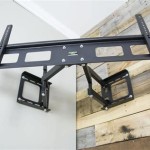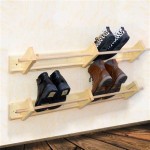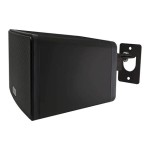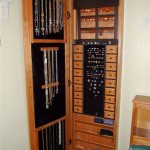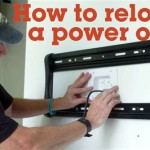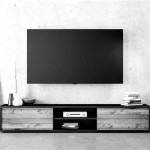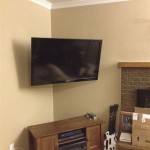Bowers & Wilkins M1 Wall Mount: Optimizing Audio Performance and Aesthetics
The Bowers & Wilkins M1 loudspeaker is a highly regarded audio solution, particularly for its compact size and exceptional sound quality. Its versatility extends to various placement options, with the wall mount offering a particularly appealing solution for those seeking to optimize both audio performance and visual appeal. Securing the M1 to a wall can significantly improve the listening experience while maintaining a clean and uncluttered aesthetic in any room. This article comprehensively explores the benefits, considerations, and practical aspects associated with utilizing the Bowers & Wilkins M1 wall mount.
The M1 is designed as a multi-functional speaker, capable of serving as a front, center, or rear channel in a home theatre setting, or as a stereo pair for music listening. The compact dimensions belie its acoustic capabilities, making it a popular choice for smaller rooms or spaces where discretion is paramount. The supplied table stand allows for immediate use, however, wall mounting expands the potential applications and optimizes the overall acoustic performance in specific room layouts. This configuration offers a streamlined appearance, freeing up floor or shelf space and ensuring the speaker's output is directed towards the listening area.
The official Bowers & Wilkins M1 wall bracket is specifically engineered to complement the speaker's design and performance characteristics. It provides a secure and stable platform for mounting the M1, while also allowing for precise aiming of the speaker towards the listening position. This adjustability is crucial for achieving optimal sound staging and imaging, particularly in multi-channel audio systems.
Key Benefits of Wall Mounting the Bowers & Wilkins M1
Wall mounting the Bowers & Wilkins M1 loudspeaker provides several distinct advantages over traditional placement methods. These include improved audio performance, enhanced aesthetic integration, and optimized space utilization.
Improved Audio Performance: Placing the M1 on a wall can significantly improve sound quality. By elevating the speaker away from reflective surfaces like floors and furniture, unwanted reflections are minimized. These reflections can cause interference with the direct sound from the speaker, resulting in a muddied or distorted audio image. When the speaker is mounted on a wall, the direct sound path to the listener is clearer, resulting in improved clarity, detail, and imaging. Moreover, the wall itself can act as a slight baffle, enhancing the bass response of the speaker, which is particularly beneficial given the M1’s compact size.
The ability to angle the speaker precisely towards the listening area is another critical advantage. This is specifically relevant in surround sound setups where the directionality of the sound effects is essential for creating an immersive experience. The Bowers & Wilkins M1 wall mount typically allows for both horizontal and vertical adjustment, enabling users to fine-tune the speaker's output for optimal sound staging and imaging in any given room configuration.
Enhanced Aesthetic Integration: The Bowers & Wilkins M1 is known for its sleek and minimalist design. Wall mounting further enhances this aesthetic by minimizing its visual footprint. When placed on a stand or shelf, the speaker inevitably occupies physical space and contributes to visual clutter. Wall mounting removes this visual obstruction, creating a cleaner and more streamlined look. Furthermore, the dedicated wall mount is designed to seamlessly integrate with the speaker's aesthetics, ensuring a cohesive and visually pleasing installation.
This integration is particularly important in contemporary living spaces where minimalist design principles are often prioritized. By mounting the M1 on the wall, the speaker becomes less obtrusive, blending seamlessly into the overall decor. This is especially beneficial in smaller rooms where maximizing space and minimizing visual clutter are crucial considerations.
Optimized Space Utilization: As previously mentioned, wall mounting frees up valuable floor or shelf space. This is a significant advantage in smaller rooms where space is at a premium. By eliminating the need for speaker stands or shelves, the available space can be utilized for other purposes. This can be particularly beneficial in home theatre setups where multiple speakers are required, as wall mounting allows for a more compact and organized arrangement.
Furthermore, wall mounting can improve safety, particularly in households with children or pets. By securing the speaker to the wall, the risk of accidental tipping or damage is significantly reduced. This is a crucial consideration in any environment where stability and safety are paramount.
Considerations Before Wall Mounting
Before proceeding with wall mounting the Bowers & Wilkins M1, several factors must be carefully considered to ensure a successful and safe installation. These include wall type and structural integrity, speaker placement and wiring, and installation tools and techniques.
Wall Type and Structural Integrity: The type of wall to which the M1 will be mounted is a critical factor. Different wall types, such as drywall, plaster, brick, or concrete, require different mounting hardware and techniques. Drywall, for example, is relatively fragile and requires the use of specialized anchors to provide sufficient support for the speaker's weight. Brick or concrete walls, on the other hand, are more robust and can support heavier loads, but require the use of masonry drill bits and appropriate anchors.
It is essential to ensure that the wall is structurally sound and capable of supporting the weight of the speaker and the wall mount. Attempting to mount the speaker on a weak or damaged wall can result in the speaker falling and causing damage or injury. If there is any doubt about the wall's structural integrity, it is advisable to consult with a professional installer.
Speaker Placement and Wiring: Careful planning of speaker placement is crucial for achieving optimal audio performance. The ideal speaker placement will depend on the room's dimensions, the seating arrangement, and the intended use of the audio system. For stereo listening, the speakers should be positioned symmetrically and at ear level when seated. For surround sound, the speakers should be placed according to the recommended configuration for the specific audio format being used (e.g., Dolby Atmos, DTS:X).
Wiring is another important consideration. The speaker wires must be routed to the speakers in a safe and aesthetically pleasing manner. This may involve running the wires through the wall, concealing them behind moldings, or using cable management solutions. It is important to use high-quality speaker wire to ensure optimal signal transmission and to avoid any potential interference or signal loss.
Installation Tools and Techniques: Proper tools and techniques are essential for a successful wall mounting installation. This includes having the appropriate drill bits, screws, anchors, and a level. It is also important to follow the manufacturer's instructions carefully to ensure that the speaker is mounted securely and correctly.
If you are not comfortable performing the installation yourself, it is advisable to hire a professional installer. A professional installer will have the necessary skills and experience to ensure that the speaker is mounted safely and correctly, and that the wiring is properly routed and concealed.
Step-by-Step Guide to Installing the Bowers & Wilkins M1 Wall Mount
While professional installation is recommended for those unfamiliar with home audio installation, the following provides a general overview of the steps involved in mounting the Bowers & Wilkins M1 using its dedicated wall bracket.
1. Gather Necessary Tools and Materials: This includes the Bowers & Wilkins M1 wall mount, a drill, appropriate drill bits for the wall type, screws and anchors suitable for the wall type, a level, a measuring tape, a pencil, a screwdriver, and speaker wire.
2. Determine Speaker Placement: Carefully consider the desired speaker placement based on the room layout and intended use (stereo, home theater, etc.). Mark the desired location on the wall with a pencil, ensuring proper height and spacing.
3. Install the Wall Mount Bracket: Using the wall mount bracket as a template, mark the screw holes on the wall. Drill pilot holes at the marked locations. If mounting on drywall, use appropriate drywall anchors. Secure the wall mount bracket to the wall using the provided screws.
4. Connect Speaker Wire: Connect the speaker wire to the M1 speaker terminals, ensuring correct polarity (+ to + and - to -). Leave enough slack in the wire to allow for adjustments.
5. Attach Speaker to Wall Mount: Following the manufacturer's instructions, attach the M1 speaker to the wall mount bracket. Ensure the speaker is securely fastened and properly aligned.
6. Adjust Speaker Angle: Adjust the speaker angle (both horizontally and vertically) to optimize sound projection towards the listening area. Use a level to ensure the speaker is properly aligned.
7. Conceal Wiring (Optional): If desired, conceal the speaker wire by running it through the wall, behind moldings, or using cable management solutions. Ensure the wiring is properly secured and does not pose a safety hazard.
8. Test Audio Performance: Test the audio performance of the speaker to ensure it is functioning correctly and that the sound quality is optimal. Make any necessary adjustments to the speaker angle or wiring.
Properly installed, the Bowers & Wilkins M1 wall mount provides a secure and aesthetically pleasing solution for optimizing both the audio performance and visual integration of this versatile loudspeaker.
Zz26271

Bowers Wilkins B W M 1 Lifestyle Satellite Speaker Pair

Bowers Wilkins M 1

Bowers Wilkins M 1 Loudspeaker Available From Hifi Gear

Bowers Wilkins M 1

Bowers Wilkins Matte White M 1 Satellite Speaker

Bowers Wilkins M1 Wall Mount 2025

The New B W M1 Overview With Hifi Gear

Bowers Wilkins M 1 Satellite Speaker Matte White

Bowers Wilkins M 1 Satellite Speaker User Guide

